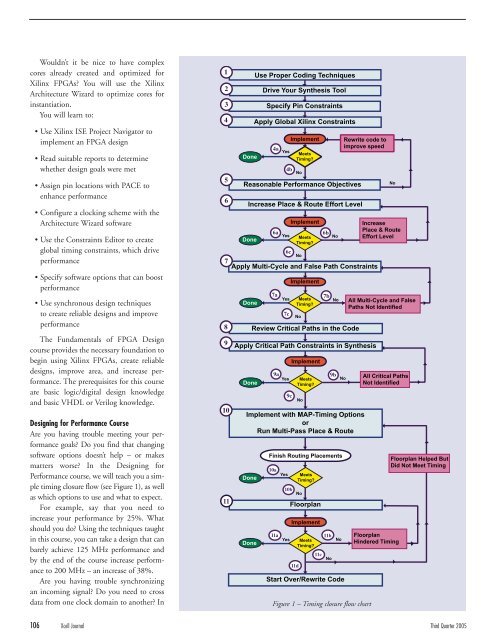Design Challenges: Avoiding the Pitfalls, winning the game - Xilinx
Design Challenges: Avoiding the Pitfalls, winning the game - Xilinx
Design Challenges: Avoiding the Pitfalls, winning the game - Xilinx
Create successful ePaper yourself
Turn your PDF publications into a flip-book with our unique Google optimized e-Paper software.
Wouldn’t it be nice to have complex<br />
cores already created and optimized for<br />
<strong>Xilinx</strong> FPGAs? You will use <strong>the</strong> <strong>Xilinx</strong><br />
Architecture Wizard to optimize cores for<br />
instantiation.<br />
You will learn to:<br />
• Use <strong>Xilinx</strong> ISE Project Navigator to<br />
implement an FPGA design<br />
• Read suitable reports to determine<br />
whe<strong>the</strong>r design goals were met<br />
• Assign pin locations with PACE to<br />
enhance performance<br />
• Configure a clocking scheme with <strong>the</strong><br />
Architecture Wizard software<br />
• Use <strong>the</strong> Constraints Editor to create<br />
global timing constraints, which drive<br />
performance<br />
• Specify software options that can boost<br />
performance<br />
• Use synchronous design techniques<br />
to create reliable designs and improve<br />
performance<br />
The Fundamentals of FPGA <strong>Design</strong><br />
course provides <strong>the</strong> necessary foundation to<br />
begin using <strong>Xilinx</strong> FPGAs, create reliable<br />
designs, improve area, and increase performance.<br />
The prerequisites for this course<br />
are basic logic/digital design knowledge<br />
and basic VHDL or Verilog knowledge.<br />
<strong>Design</strong>ing for Performance Course<br />
Are you having trouble meeting your performance<br />
goals? Do you find that changing<br />
software options doesn’t help – or makes<br />
matters worse? In <strong>the</strong> <strong>Design</strong>ing for<br />
Performance course, we will teach you a simple<br />
timing closure flow (see Figure 1), as well<br />
as which options to use and what to expect.<br />
For example, say that you need to<br />
increase your performance by 25%. What<br />
should you do? Using <strong>the</strong> techniques taught<br />
in this course, you can take a design that can<br />
barely achieve 125 MHz performance and<br />
by <strong>the</strong> end of <strong>the</strong> course increase performance<br />
to 200 MHz – an increase of 38%.<br />
Are you having trouble synchronizing<br />
an incoming signal? Do you need to cross<br />
data from one clock domain to ano<strong>the</strong>r? In<br />
1<br />
2<br />
3<br />
4<br />
5<br />
6<br />
Done<br />
Use Proper Coding Techniques<br />
Drive Your Syn<strong>the</strong>sis Tool<br />
Apply Global <strong>Xilinx</strong> Constraints<br />
Implement<br />
Increase Place & Route Effort Level<br />
Done<br />
6c<br />
No<br />
7<br />
Apply Multi-Cycle and False Path Constraints<br />
8<br />
9<br />
10<br />
11<br />
Done<br />
Specify Pin Constraints<br />
106 Xcell Journal Third Quarter 2005<br />
4a<br />
Yes<br />
6a<br />
Yes<br />
Yes<br />
Meets<br />
Timing?<br />
No<br />
Reasonable Performance Objectives<br />
Implement<br />
Meets<br />
Timing?<br />
Implement<br />
Meets<br />
Timing?<br />
No<br />
No<br />
6b<br />
No<br />
7b<br />
No<br />
Review Critical Paths in <strong>the</strong> Code<br />
Rewrite code to<br />
improve speed<br />
Apply Critical Path Constraints in Syn<strong>the</strong>sis<br />
Done<br />
Implement<br />
Meets<br />
Timing?<br />
Implement with MAP-Timing Options<br />
or<br />
Run Multi-Pass Place & Route<br />
Done<br />
Done<br />
7a<br />
9a<br />
Yes<br />
Finish Routing Placements<br />
10a<br />
Yes<br />
4b<br />
7c<br />
9c<br />
10b<br />
No<br />
Meets<br />
Timing?<br />
No<br />
Floorplan<br />
Implement<br />
11a<br />
Yes Meets<br />
Timing?<br />
11b<br />
11d<br />
11c<br />
No<br />
9b<br />
No<br />
No<br />
Start Over/Rewrite Code<br />
Figure 1 – Timing closure flow chart<br />
No<br />
Increase<br />
Place & Route<br />
Effort Level<br />
All Multi-Cycle and False<br />
Paths Not Identified<br />
All Critical Paths<br />
Not Identified<br />
Floorplan<br />
Hindered Timing<br />
Floorplan Helped But<br />
Did Not Meet Timing

















